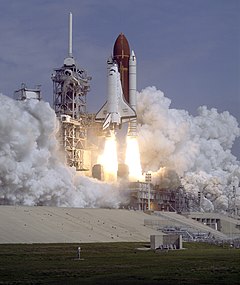 CGRO deployed in 1991 | |||||||||||
| Mission type | Astronomy | ||||||||||
|---|---|---|---|---|---|---|---|---|---|---|---|
| Operator | NASA | ||||||||||
| COSPAR ID | 1991-027B | ||||||||||
| SATCAT no. | 21225 | ||||||||||
| Website | cossc | ||||||||||
| Mission duration | 9 years, 2 months | ||||||||||
| Spacecraft properties | |||||||||||
| Manufacturer | TRW Inc. | ||||||||||
| Launch mass | 16,329 kilograms (35,999 lb) | ||||||||||
| Power | 2000.0 Watts[1] | ||||||||||
| Start of mission | |||||||||||
| Launch date | 5 April 1991, 14:22:45 UTC | ||||||||||
| Rocket | Space Shuttle Atlantis STS-37 | ||||||||||
| Launch site | Kennedy LC-39B | ||||||||||
| End of mission | |||||||||||
| Decay date | 4 June 2000, 23:29:55 UTC | ||||||||||
| Orbital parameters | |||||||||||
| Reference system | Geocentric | ||||||||||
| Regime | Low Earth | ||||||||||
| Eccentricity | 0.006998 | ||||||||||
| Perigee altitude | 362 kilometres (225 mi) | ||||||||||
| Apogee altitude | 457 kilometres (284 mi) | ||||||||||
| Inclination | 28.4610 degrees | ||||||||||
| Period | 91.59 minutes | ||||||||||
| RAAN | 68.6827 degrees | ||||||||||
| Epoch | 7 April 1991, 18:37:00 UTC[2] | ||||||||||
| Main Telescopes (Four) | |||||||||||
| Type | Scintillation detectors | ||||||||||
| Focal length | Varied by instrument | ||||||||||
| Collecting area | Varied by instrument | ||||||||||
| Wavelengths | X-ray to γ-ray, 20 keV – 30 GeV (40 pm – 60 am) | ||||||||||
| |||||||||||
Large Strategic Science Missions Astrophysics Division | |||||||||||


The Compton Gamma Ray Observatory (CGRO) was a space observatory detecting photons with energies from 20 keV to 30 GeV, in Earth orbit from 1991 to 2000. The observatory featured four main telescopes in one spacecraft, covering X-rays and gamma rays, including various specialized sub-instruments and detectors. Following 14 years of effort, the observatory was launched from Space Shuttle Atlantis during STS-37 on April 5, 1991, and operated until its deorbit on June 4, 2000.[3] It was deployed in low Earth orbit at 450 km (280 mi) to avoid the Van Allen radiation belt. It was the heaviest astrophysical payload ever flown at that time at 16,300 kilograms (35,900 lb).
Costing $617 million,[4] the CGRO was part of NASA's Great Observatories series, along with the Hubble Space Telescope, the Chandra X-ray Observatory, and the Spitzer Space Telescope.[5] It was the second of the series to be launched into space, following the Hubble Space Telescope. The CGRO was named after Arthur Compton, an American physicist and former chancellor of Washington University in St. Louis who received the Nobel prize for work involved with gamma-ray physics. CGRO was built by TRW (now Northrop Grumman Aerospace Systems) in Redondo Beach, California. CGRO was an international collaboration and additional contributions came from the European Space Agency and various universities, as well as the U.S. Naval Research Laboratory.
Successors to CGRO include the ESA INTEGRAL spacecraft (launched 2002), NASA's Swift Gamma-Ray Burst Mission (launched 2004), ASI AGILE (satellite) (launched 2007) and NASA's Fermi Gamma-ray Space Telescope (launched 2008); all remain operational as of May 2023.
- ^ "NASA – NSSDCA – Spacecraft – Details". nssdc.gsfc.nasa.gov. Retrieved 2018-04-30.
- ^ "NASA – NSSDCA – Spacecraft – Trajectory Details". nssdc.gsfc.nasa.gov. Retrieved 2018-04-30.
- ^ "Gamma-Ray Astronomy in the Compton Era: The Instruments". Gamma-Ray Astronomy in the Compton Era. NASA/ GSFC. Archived from the original on 2009-02-24. Retrieved 2007-12-07.
- ^ Cite error: The named reference
sfn2000was invoked but never defined (see the help page). - ^ Barry Logan : MSFC, Kathy Forsythe : MSFC. "NASA – NASA's Great Observatories". www.nasa.gov. Archived from the original on 2011-08-20. Retrieved 2020-11-02.